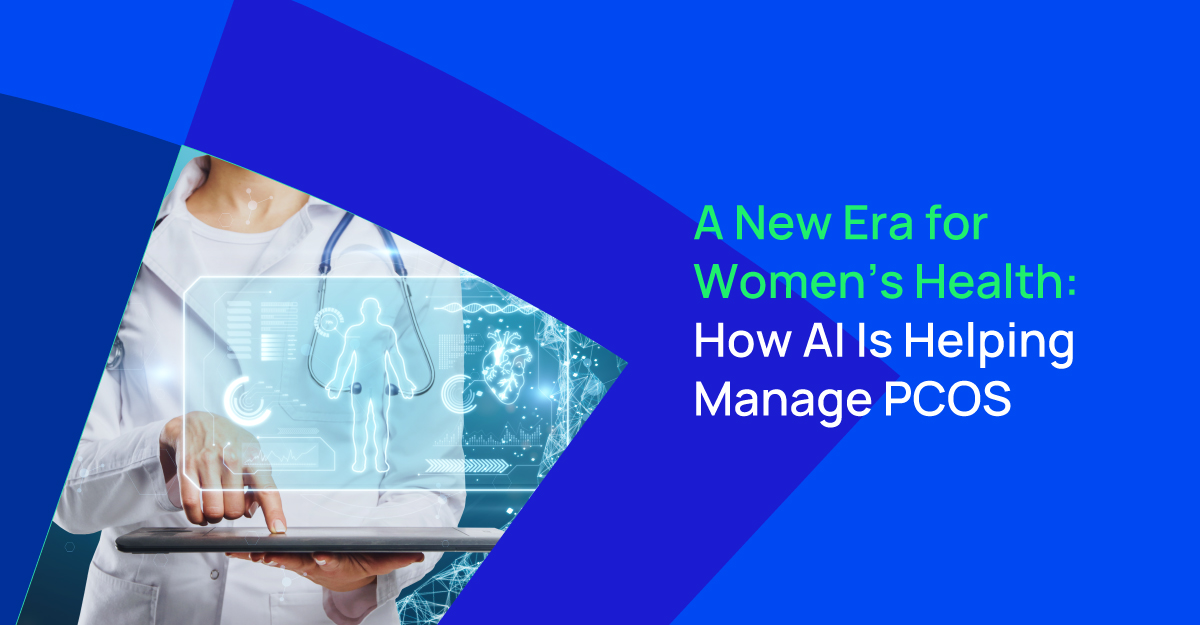About 10% of women in their reproductive years experience PCOS (also referred to as PCOD). It's not a matter of skipping a period or two—PCOS impacts daily life.
From weight change and acne breakouts to reproductive issues and mood swings, having PCOS can sometimes seem like a nonstop struggle.
Though medicine and lifestyle modification remain the main therapies, AI is now intervening to assist women in better knowing and coping with this disorder.
Let's see the difference that today's smart AI apps and tools are making in women's health.
What is PCOD?
The disorder known as PCOD occurs when a woman's ovaries create an excessive quantity of androgens, or male hormones, causing an imbalance that impacts the menstrual cycle and results in symptoms like:
- Period irregularities
- Gaining weight or having trouble losing it
- Overgrowth of hair (hirsutism)
- Oily skin with acne
- Hair loss or thinning of the scalp
- Inability to conceive (because of irregular ovulation)
PCOD is frequently difficult to manage because these symptoms might differ greatly from woman to woman. To help women better manage these symptoms, AI-driven technologies are offering customised, data-driven solutions.
How AI-Driven Health Monitoring Systems Help Women Manage PCOD
AI-driven health monitoring solutions give women with PCOD a more individualised approach to managing their illness by gathering, evaluating, and interpreting health data in real-time. AI can help in the following ways:
1. Monitoring Hormonal Imbalances in Real Time
PCOD results from imbalances in hormones, mainly, yet measurement of hormone levels has traditionally involved periodic laboratory testing. When used in connection with wearable devices, AI-driven monitoring systems can monitor symptoms related to hormone oscillations continuously. Such systems can monitor:
Changes in body temperature (which could be a sign of ovulation or other hormonal changes)
- Stress and hormonal changes might have an impact on heart rate variability.
- Skin disease, monitoring oil production, or acne that varies with hormonal shifts
- Sleep patterns: Hormonal abnormalities may be indicated by sleep disturbances.
Artificial intelligence (AI) algorithms can use this data to forecast when a hormone imbalance might arise, find patterns, and offer tailored feedback, enabling early intervention.
2. Predicting Ovulation and Menstrual Cycle
Irregular menstruation is a central symptom of PCOD. These systems can forecast the ovulation and menstruation cycles by keeping track of menstrual cycles and using AI to analyze cycle patterns in duration, bleeding flow, and interval. PCOD sufferers can be better assisted by AI-driven apps in managing their symptoms or planning for a baby through remembering and reminding features.
3. Personalized Weight Management
Women with PCOD frequently battle with weight gain. Numerous health variables, including physical activity, calories burned, sleep habits, and hormone variations that affect weight, can be tracked by AI systems. To maintain a healthy weight, which is essential for managing PCOD, the system can provide customised meal plans, exercise routines, and lifestyle changes based on this data.
4. Mental Health Monitoring and Support
Since PCOD presents both physical and mental issues, women with the disorder frequently have greater levels of stress, anxiety, and melancholy. AI-powered chatbots or mental health applications that offer stress-relieving activities, mindfulness exercises, and cognitive behavioural therapy (CBT) techniques can offer round-the-clock help.
In addition to tracking mood trends, AI systems can assist women in identifying the things that make them feel anxious or depressed about their PCOD symptoms. Based on these mood insights, AI can make suggestions, such as doing soothing activities or going to therapy if necessary.
5. Tracking Fertility and Pregnancy
AI-driven systems can offer useful information on a woman's window of fertility if she has PCOD and is having trouble becoming pregnant. Artificial intelligence (AI) algorithms can assist women in better understanding their reproductive health by monitoring ovulation cycles, cervical mucus, basal body temperature, and other fertility indicators.
AI-based monitoring solutions can also notify women of any health issues, including diabetes or high blood pressure, that may impair pregnancy. This makes it possible to intervene early and guarantees that women get the help they require for a safe pregnancy.
6. AI-Driven Telemedicine and Remote Consultations
Women can consult with medical professionals remotely by integrating AI-driven health monitoring systems with telemedicine platforms. Doctors can give quicker and more precise recommendations with real-time data on symptoms, hormone levels, and general health, which eliminates the need for frequent in-person consultations.
Additionally, telemedicine platforms give women a more comfortable setting to talk about their health issues and lessen the stigma attached to PCOD.
Benefits of AI-Driven Health Monitoring Systems for Women with PCOD
1.Personalised Medical Care
AI can develop a custom treatment and management plan based on a woman's particular health requirements through analyzing individual health data. AI assists women in making health-related decisions by tracking menstrual cycles, making lifestyle recommendations, and recommending drugs.
2. Prevention and Early Detection
Women with PCOD are more likely to develop comorbidities like diabetes or cardiovascular disease, and AI can assist in identifying these issues early. AI can spot patterns and alert users to possible health hazards via predictive analytics, facilitating early action and lowering long-term issues.
3. Better Control of Fertility
AI makes it easier for women with PCOD to conceive or avoid getting pregnant by tracking their reproductive cycle. Women can better control their fertility, whether or not they are attempting to conceive, by observing hormone variations and learning when ovulation occurs.
4. Better Accessibility
By enabling remote monitoring and consultations, AI-powered health monitoring systems increase access to healthcare. AI-driven platforms can help women who live in remote places or have limited access to medical facilities by offering support without requiring them to leave their homes.
Conclusion
AI-driven health monitoring technologies are transforming women's PCOD treatment through early intervention, personalization of care, and real-time analytics.
These innovations provide women experiencing PCOD a better and proactive method of managing their well-being through wearable data, predictive analytics, and AI algorithms.
With the advancement of AI in the future, it will be even more essential in helping women cope with PCOD, enhancing their quality of life and healthcare outcomes.



